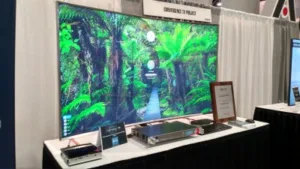Deployment of ATSC 3.0 is off and running, with a strong showing this month at this year’s NAB Conference in Las Vegas. More than 40 exhibitors and 22 technology-and-business sessions demonstrated the level of interest in the new standard, with a ribbon-cutting ceremony starting the activities.
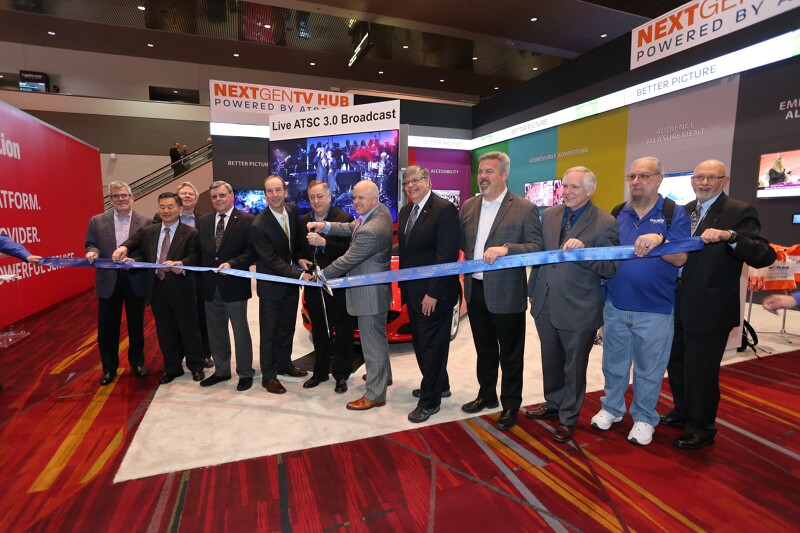 “Powered by ATSC 3.0” Ribbon Cutting Ceremony
“Powered by ATSC 3.0” Ribbon Cutting Ceremony
Our coverage begins with a status report, and then considers the outlook for business and product development. (To make for a more cohesive story, we take editorial privilege here and intertwine the speakers and sessions).
The Road to ATSC 3.0
ATSC President Mark Richer underscored the level of 3.0 presence at the show, saying “That’s how we know it’s real, and that’s how we know it’s happening,” and Sam Metheny, EVP/CTO at NAB, said that while ATSC is now “moving to the implementation phase,” it is a “living standard that will continue to evolve over time.” Mike Bergman, ?Senior Director, Technology & Standards at the Consumer Technology Association, anticipates “broad deployment, and a breathtakingly immersive viewing experience,” which should complement the growing momentum of 4K TV sales.
Sinclair and its subsidiary One Media this week signed a memorandum of understanding (MoU) with cloud solutions company Gaian Solutions, to work together to create a Next Generation Broadcast Platform (NGBP), leading to deployment of an OTT-OTA hybrid proof-of-concept before the end of the year. Mark Aitken, SVP at Sinclair Broadcast Group, expects their deployment in the Dallas Designated Market Area (DMA) to be an open test bed for broadcasters, as a first step toward a national launch.
 Chart courtesy Rich Chernock, TriVeniInteractive “hybrid” demonstrations of Amber alerts and hazardous materials (“HazMat”) alerts at the NAB Show showed the IP-based capabilities of Next Gen TV. Several standards in the ATSC 3.0 suite of standards can be used to deliver advanced alerts, according to emergency alerting alliance AWarn Executive Director John Lawson. He said
Chart courtesy Rich Chernock, TriVeniInteractive “hybrid” demonstrations of Amber alerts and hazardous materials (“HazMat”) alerts at the NAB Show showed the IP-based capabilities of Next Gen TV. Several standards in the ATSC 3.0 suite of standards can be used to deliver advanced alerts, according to emergency alerting alliance AWarn Executive Director John Lawson. He said
“Increasingly, the Alliance is providing the nexus between the Next Gen TV development community and the nation’s emergency managers. Our goal is not only to create the architecture for delivering geo-targeted advanced alerts, but also design rich media and accessible messages that lead to life-saving action by the public”.
Lawson also mentioned a recent workshop co-convened by the U.S. Department of Homeland Security Science and Technology Directorate and the AWarn Alliance and hosted by the Consumer Technology Association in Arlington, VA.
To dramatically demonstrate the mobile capabilities of the ATSC 3.0 standard, show attendees were able to watch live ATSC 3.0 broadcasts from the comforts of an 11-seat self-driving vehicle which was available to shuttle them between the busy Central and South Halls of the Las Vegas Convention Center.
 Driverless Vehicle (front shown) Shuttles Passengers Viewing Mobile ATSC 3.0 Content
Driverless Vehicle (front shown) Shuttles Passengers Viewing Mobile ATSC 3.0 Content
Where Are We and Where Are We Headed – Maximizing the Potential of ATSC 3.0
Now that the ATSC 3.0 standard has been approved, broadcasters can develop two-way, IP-based connections with their viewers and deliver TV experiences on a par with other digital media. Looking to the future, conference panelists addressed key Next Gen TV capabilities, including enhanced audience insights, addressable advertising, interactivity, and personalization, along with plans to generate incremental revenue and audience engagement.
New to NAB this year was a set of small-group presentations with multiple speakers in a room. TriVeni CTO Rich Chernock was one such presenter, who said that broadcasters are used to slow change, but now need to change faster, even on a monthly basis. The world is changing faster, and consumer demands are changing, with OTA viewership growing, and OTT services and usage growing. Mobile viewing continues to increase, a cord cutting / shaving / nevers are changing TV marketplace dynamics. On-demand viewing is an assumed feature, and digital advertising is increasingly powerful, so targeted advertising is now essential.
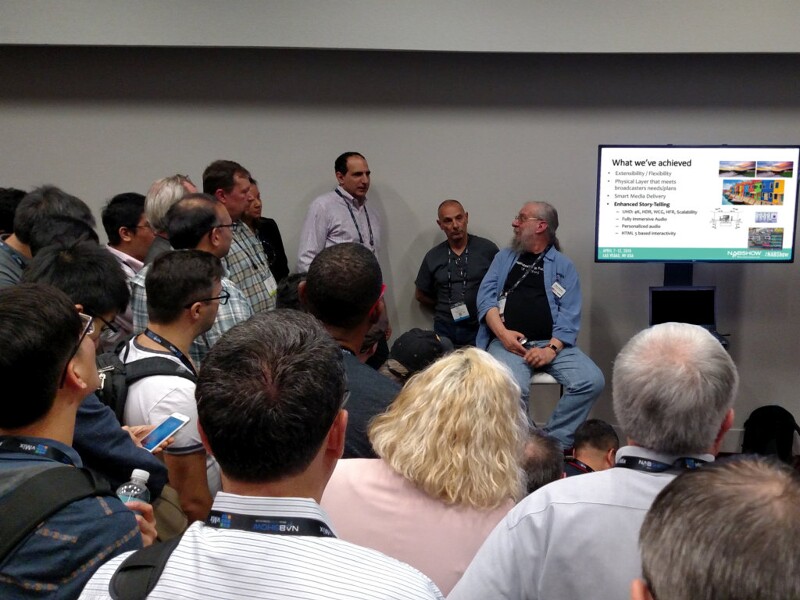 TriVeni’s Rich Chernock Draws a Crowd at NAB Small-group Presentation
TriVeni’s Rich Chernock Draws a Crowd at NAB Small-group Presentation
At a panel discussion, Mark Aitken, SVP at Sinclair Broadcast Group, said that SFNs (single-frequency networks, a broadcast technology comparable to mobile cellular networks) will enable all of these new services, and data analytics will drive the opportunities. “Gotta figure out the back channel,” he said, referring to the logistics and revenue-generation behind the WiFi/mobile broadband return channel defined by ATSC 3.0. “Even simple receivers need a back channel,” he stressed.
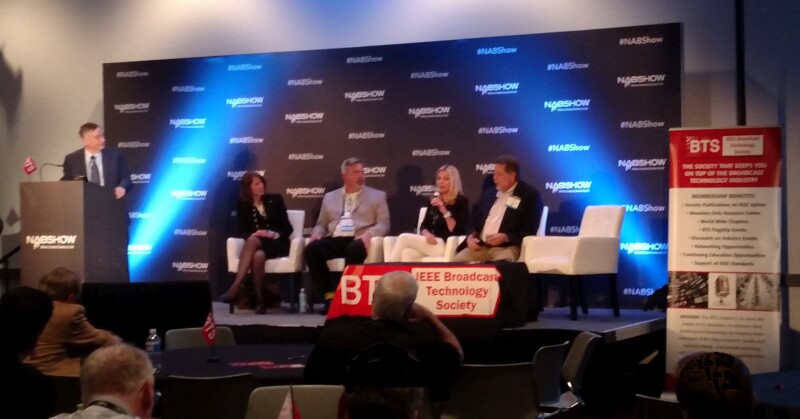 ATSC President Mark Richer Queries Session Panelists (L-R):Madeleine Noland, Pete Sockett, Anne Schelle, Mark Aitken.
ATSC President Mark Richer Queries Session Panelists (L-R):Madeleine Noland, Pete Sockett, Anne Schelle, Mark Aitken.
While MVPDs (Multichannel video programming distributors, i.e. cable and satellite) have long provided a revenue stream to broadcasters through retransmission-consent agreements, this could be one key area of the change in business model made possible by ATSC 3.0, which is not mandated by the FCC, and whose carriage is not subject to retrans obligations.
The Sinclair SFN trials in Dallas, which also involve Nexstar, Univision, and Dish Network, and are expected to carry 2 HD plus 7 SD channels, will develop and build support for mobile reception, according to Aiken, who said Sinclair is interested in gathering viewership data from mobile devices and doing dynamic ad insertion. “Reaching individuals will be attractive to advertisers,” he said, and Sinclair “can put movies into home boxes for Netflix – we can now bypass MVPDs”.
“The standard is capable of doing what we wanted so long,” said Aitken, “hybrid opportunities, and dynamic ad insertion.. ATSC M/H (the mobile part of what could be called ATSC 1.5) drilled in the importance of mobility. We’ve said ‘Mobile first’ – not the only thing, but an important part.”
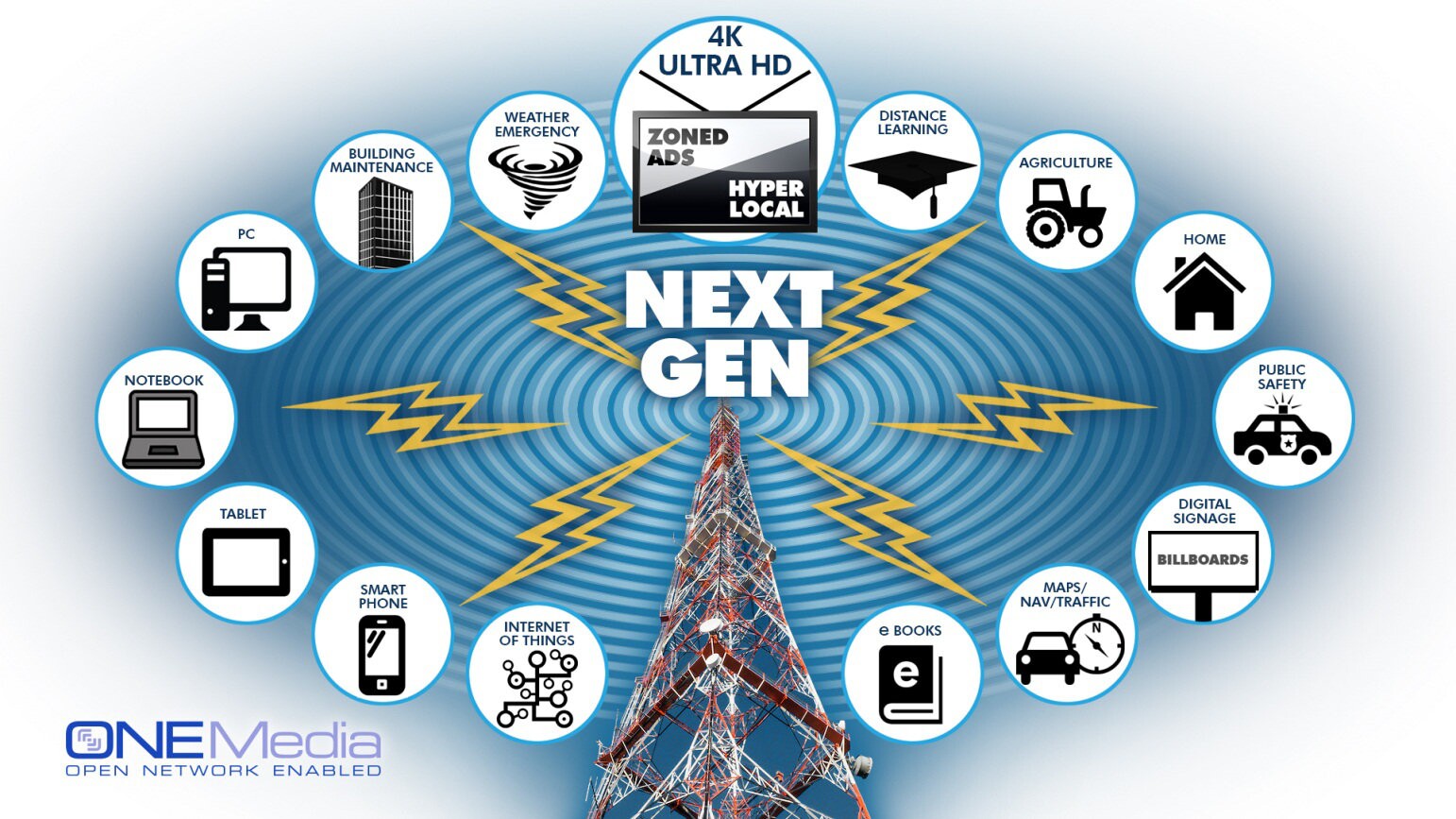 Sinclair Concept for Next Generation TV. Click for higher resolution
Sinclair Concept for Next Generation TV. Click for higher resolution
ATSC 3.0 is thus poised as a medium to test new business models, a theme echoed by Jerald Fritz, Sinclair EVP Strategic and Legal Affairs. “Non-TV digital services will require a consortium for Conus footprint, he said, which suggests a new way for local broadcasters to deliver content. “With Dish on (channel) 56, why not rent bits from broadcasters for the last mile?”, he asks. Translation: broadcasters can partner with other spectrum owners and mobile carriers to supplement the “traditional” mobile spectrum.
Fritz also mentioned a potential challenge that could come with spectrum flexibility: multiple receiver scans will be needed as broadcasters move around the spectrum, both during the current FCC spectrum reallocation, as well as in the future, as services change. One solution is to have a spectrum manager handle market channels in a dynamic fashion, such as the consortium formed in January, Spectrum Co., which was founded by Sinclair and Nexstar Media Group. Univision is also a member of the consortium.
Pearl TV President Anne Schelle, announced that broadcasters lit up ATSC 3.0 transmitters at April 6, as part of the Phoenix Model Market Project. “Today’s announcement is just the first Phoenix station to transition to ATSC 3.0, with additional partner stations to be added soon,” she said, as she described the new service on opening day of the NAB Show.
The Phoenix Model Market project is the first collaborative single-market effort to plan for and implement a transition to next-generation over-the-air television broadcasting. Twelve stations in the Phoenix market are participating, with service testing expected to start Q2’18, and consumer service testing in Q4’18. In addition to business model testing, consumer testing will extend into 2019.
 Phoenix Project partners will be showing how next-generation ATSC 3.0 technology can be deployed while maintaining existing digital TV service for viewers. Among the consumer-facing business models to be tested are program guide & hybrid TV, personalization, and emergency alerts. On the broadcaster side, content protection, data & measurement, advanced advertising, and transition models will be evaluated.
Phoenix Project partners will be showing how next-generation ATSC 3.0 technology can be deployed while maintaining existing digital TV service for viewers. Among the consumer-facing business models to be tested are program guide & hybrid TV, personalization, and emergency alerts. On the broadcaster side, content protection, data & measurement, advanced advertising, and transition models will be evaluated.
New to the Phoenix Model Market effort are participating consumer electronics manufacturers LG Electronics, Sony, Samsung, and Channel Master. “More announcements are coming, because the Phoenix Model Market is an open test bed environment and we plan to work with additional suppliers and share our findings broadly with the industry,” Schelle said.
LG Electronics is the first consumer electronics manufacturer to supply integrated ATSC 3.0 television receivers for evaluation and monitoring in Phoenix this spring; the company is already marketing dual reception ATSC 3.0/1.0 TV products in South Korea.
Sony Electronics will supply televisions, demodulators and application development tools for ATSC 3.0. Sony will collaborate with Pearl TV, not only in developing the Electronic Program Guide, but also in testing technology and service models.
Samsung brings their expertise to the Phoenix Model Market project having rolled out ATSC 3.0 TVs widely in South Korea. That experience will help the Phoenix Project focus on evaluation of features such as HDR and immersive audio. Additionally, Samsung’s support of ATSC 3.0 applications and online services will facilitate the testing of advanced features for next-generation TVs in the U.S.
Channel Master, which is based in the Phoenix metropolitan area, will supply a variety of reception antenna products and lend its professional signal evaluation expertise to the project, including development of future products designed to enhance digital TV reception.
At the Phoenix Model Market kiosk in the “Road to ATSC 3.0” exhibit at the NAB Show, Sony detailed the capabilities of the ATSC A/344 standard for interactivity, with a Sony-designed run-time environment that showed how interactivity can occur with next-generation TV. The system allows adaptive ad insertion and messaging displayed with real-time object delivery over unidirectional transport as well as dynamic adaptive streaming over HyperText Transfer Protocol. These are commonly known as Route and Dash and can operate seamlessly to enable new experiences such as loyalty and viewing history offerings like coupons and purchase choices.
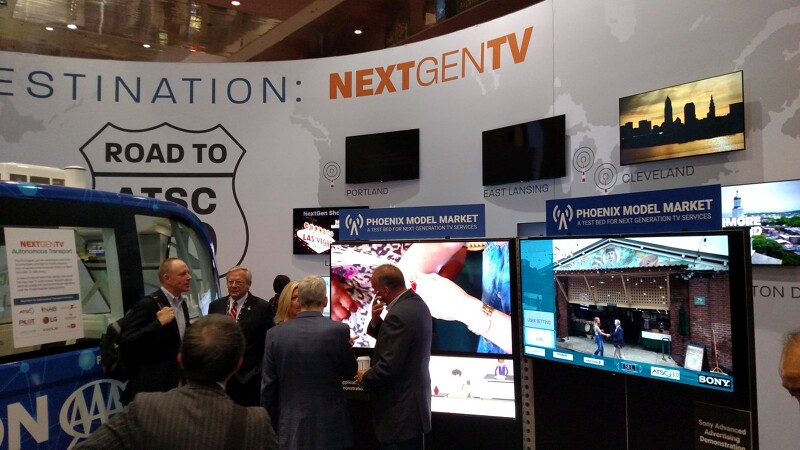 Phoenix Model Market Demos Interactive Features at NAB
Phoenix Model Market Demos Interactive Features at NAB
Using an ATSC 3.0 receiver provided by LG Electronics, Yotta Media Labs demonstrated a prototype application that local broadcasters could use with ATSC 3.0, allowing the viewer to access and discover content through a modern TV guide embedded in the broadcaster’s channel. The sample ATSC 3.0 app showed a potential experience that over-the-air viewers would get on smart TVs connected to the internet.
Phoenix Model market partners also launched an informational website, www.phoenixnextgentv.com, to provide information about the Model Market for Phoenix viewers, to fully inform the public about the ATSC 3.0 testing that has just begun in Phoenix. The site provides advice for viewers, including notifications that cable and satellite viewers are not affected by the over-the-air signal changes.
Schelle described how 3.0 is truly different from its predecessors. “Dial-TV (the previous attempt at ATSC 1.0 interactivity) didn’t work very well, and DVB-T2 is too old,” adding, “how do we take broadcasting to Internet and IP – how do we enhance it? – with data collection.” The “model market” project will also determine the appeal of high dynamic range video and immersive audio content to consumers.
ATSC 3.0 was developed to make use of the return channel, according to Winston Caldwell, VP, Fox Networks Group. “We see usage reporting to be of great value in the future,” he said, along with “OTA efficiency, indoor reception, and availability to consumers on the go”.
John Hoctor, CEO & Co-Founder of Data+Math, said that Google “is a large part of local TV advertising,” suggesting that 3.0 interactivity can parallel or enhance the revenue channel, and quantifying receiver usage will show 3.0’s value to marketers. He suggested that numbers in small panel “over-index,” meaning that current methods of tracking are not as accurate as they might be. Much larger data set helps optimize value of inventory.
Key enabling features of 3.0 valued by Eric Anderson, SVP for Verance, include a common user experience across channels, 1.0-3.0 harmonization (backward compatibility), and personalization.
Convergence TV Project Demonstrates First SHVC-Based HD/UHD Hybrid Delivery
At NAB 2018, the Convergence TV project demonstrated the delivery of a full UHDTV service using an ATSC 3.0 broadcast path for distributing a regular HD service (2k + HDR) and an ATSC 3.0 broadband path for enhancing the service from HD to UHDTV (4K + HDR) – a “world-first,” according to the project.
Convergence TV is a research project powered by five French companies: TeamCast (lead), ATEME, Broadpeak, Motion Spell, TDF and two academic research institutes, INSA Rennes and Telecom Paristech. The main objective of the project is to work on hybrid delivery of advanced TV services; it is sponsored by the French government and two local councils (Region Bretagne and Region Ile-De-France).
By using scalable HEVC (SHVC) for audio & video compression, no simulcasting is needed. The broadcast path delivers the HD signal while the broadband path delivers only the enhancement signal from HD to UHD.
 SHVC-Based HD/UHD Hybrid DeliveryBoth paths are fed from a single SHVC encoder providing the base layer signal to the broadcast chain and the enhancement layer to the broadband chain. Two receivers demonstrated the service enhancement: an ATSC 3.0 TV displaying the basic 1920p HD HDR service, and a PC-based hybrid receiver prototype that combined the base and enhancement layers in a SHVC decoder.
SHVC-Based HD/UHD Hybrid DeliveryBoth paths are fed from a single SHVC encoder providing the base layer signal to the broadcast chain and the enhancement layer to the broadband chain. Two receivers demonstrated the service enhancement: an ATSC 3.0 TV displaying the basic 1920p HD HDR service, and a PC-based hybrid receiver prototype that combined the base and enhancement layers in a SHVC decoder.
The regular ATSC 3.0 TV set showed the backward compatibility of the approach, because a regular HEVC-enabled TV set can decode the SHVC base layer without requiring a specific upgrade. Samsung supported the demo by providing the ATSC 3.0 TV set for the backward compatibility demonstration.
The demo set out to showcase one of the exclusive features of the ATSC 3.0 system approach – the native hybrid delivery mechanism. It illustrates a business case where regular broadcast HD service delivery (2K) can be enriched to UHD (4K) – and monetized – through an optional broadband connection, the so-called “freemium” pricing strategy.
Projects Manager Alain Untersee described the two-year project and the underlying technology. “ATSC 3.0 is natively hybrid, with full IP,” he said, “but DVB-T2 is not designed as a hybrid medium, and is not IP.” (T2 uses the MPEG Transport Stream for content multiplexing, vs. the Internet-Protocol stream-based ATSC 3.0). The project is therefore aimed at demonstrating the value of an ATSC 3.0 service layer over the DVB-T2 PHY (physical, or transmission) layer.
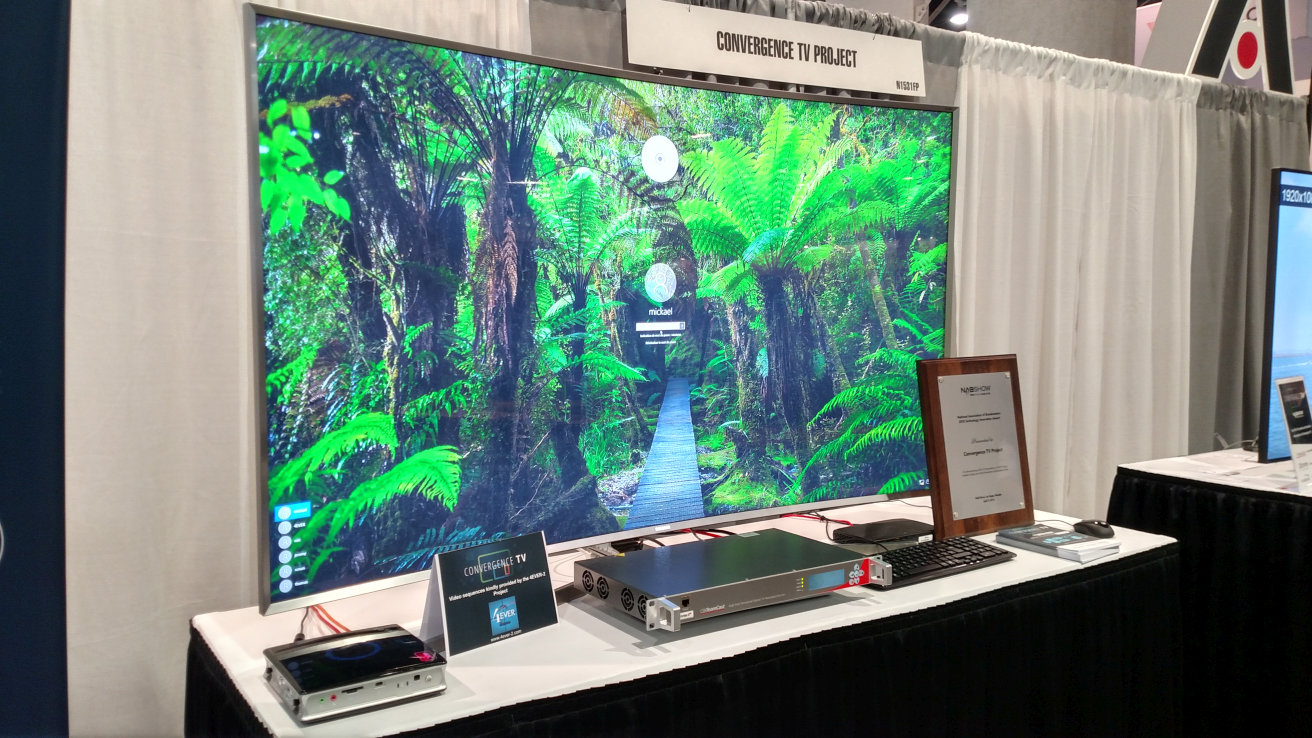 Convergence TV Project demonstrates Hybrid 4k/2k BroadcastThe enhancement layer is 2x base layer, according to Untersee, and full (single-layer) 4k uses about the same total bandwidth as base plus enhancement. On a 4k set, upscaling can be done for fallback, if there is a loss of the enhancement data.
Convergence TV Project demonstrates Hybrid 4k/2k BroadcastThe enhancement layer is 2x base layer, according to Untersee, and full (single-layer) 4k uses about the same total bandwidth as base plus enhancement. On a 4k set, upscaling can be done for fallback, if there is a loss of the enhancement data.
The French government is in the process of considering a 2nd-generation DVB system – France uses MPEG-2 for free SD and H.264/AVC for free HD and pay services – and is thus being lobbied by the Convergence TV project supporters to implement a mixed ATSC/DVB system. “Scalable coding works better,” says Untersee, “and could be more efficient, [thus enabling] more business cases. France TV needs this, which will put pressure on scalable [coding], and [France] will switch to T2 by 2024.”
While there is no commercial encoding equipment available yet, project member ATEME is certainly considering its options.

